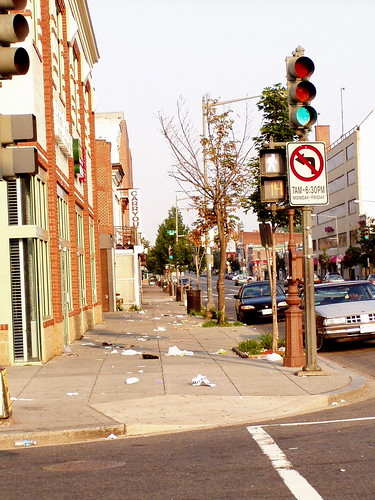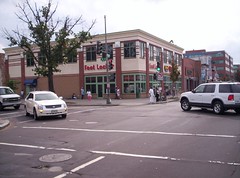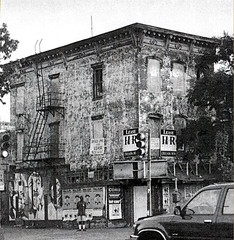It helps to have good PR agents
Today's Post has an article, Long-Awaited Revival for H Street Corridor, about the neighborhood that has served as my primary "laboratory" for learning about urban revitalization. I think the article isn't very nuanced...
For example, this sentence: "The H Street Community Development Corp. and the District put up about $1 million about two years ago to redo a rundown corner at H and Eighth streets NE, according to D.C. officials,"* refers to the building pictured below, which I don't see how anyone can see is a "revitalizing" improvement:
 Photo by Elise Bernard.
Photo by Elise Bernard. Photo by Richard Layman.
Photo by Richard Layman.I'd recommend reading what I wrote about this project in 2002, before it was built or this about the kinds of businesses by and large attracted to the H Street corridor, in a long assessment of H Street and the community revitalization agenda on the corridor (first written in August 2004 and entered into the blog in March 2005).
* Or read this blog entry from the summer, "Falling up -- Accountability and DC Community Development Corporations," which discusses past articles from the Washington Post about this and related projects:
-- Federal Money Flowed With Little Oversight: City Promises to Cut Off Ineffectual Groups. Carol D. Leonnig; The Washington Post; Feb 24, 2002; pg. A.13
- D.C. Revitalization Promised, Not Delivered: Nonprofits Collect Millions as Work Goes Undone, Neighborhoods Left With Eyesores.
Carol D. Leonnig Marcia Slacum Greene and Yolanda Woodlee; The Washington Post; Feb 24, 2002; pg. A.01
- Risky Ventures, Little Accountability: After Years of Public Funding, Nonprofits Have Completed Few Projects
Marcia Slacum Greene Yolanda Woodlee and Carol D. Leonnig; The Washington Post; Feb 25, 2002; pg. A.01
-Blighted Sites May Revert To D.C.: Revival Has Stalled Under Nonprofits
Carol D. Leonnig and Yolanda Woodlee; The Washington Post; Feb 26, 2002; pg. B.01
-$100 Million Down the Drain [Editorial]
The Washington Post. Washington, D.C.: Feb 28, 2002. pg. A.22
- D.C. Housing Authority Fines Nonprofit: Development Group Sold Two Row Houses, Meant for Individuals, to Investor
Carol D. Leonnig; The Washington Post; May 3, 2002; pg. B.05
-Criticized Nonprofit Could Get $1 Million; Council May Fight Plans for H St. NE;
Yolanda Woodlee. The Washington Post. Washington, D.C.: Jun 4, 2002. p. B.01
Fortunately, independent investment in large projects will spur positive changes, even while most of the extant retail businesses aren't responding to changes in the market.
But many many articles like today's have been written over the years. Who remembers what we all thought would happen in the neighborhood when Union Station reopened in 1988? It still hasn't happened in the commercial district, while the neighborhood has in fact changed significantly.
It's really about "The Building Blocks of Revitalization" (another blog entry from March, which I am reprinting below:
The book House by House, Block by Block: Rebuilding America's Urban Neighborhoods, by Alexander von Hoffman, details success stories in urban revitalization. According to the book, there are five common threads to stitching a challenged community back together:
A sense of place. A community has to see itself as worth saving. It needs a central idea around which people can coalesce - whether it's a history visible in cobbled streets and gaslights, a central church or school about which people who've stayed in the neighborhood have fond memories, or something as simple as a name.
A group of tenacious leaders, reflective of the whole community. Reviving neighborhoods need "people with a certain kind of courage - maybe even foolish courage - in the face of devastation," says von Hoffman. That doesn't mean one charismatic leader. It means a broad coalition, including the "usual voices" - activists, religious and political leaders, philanthropists, developers - and voices less commonly heard: members of all the area's major ethnic groups, ordinary citizens who've never been politically active in their lives.
A problem, and good conversation about it. Groups start with a shared sense that their community has a problem. They probably don't agree on what that problem is, and they certainly don't agree on what to do about it. So the first step is to facilitate an exchange in which every voice gets heard, every grievance aired. This is a slow process, as everyone who's taken part in such a conversation acknowledges, because fundamentally it's about trust, and trust doesn't happen on a deadline. If participants have the patience to see the process through, however, they almost invariably arrive at a common sense of the problem they're facing - and a common vision of how to tackle it.
A sustainable plan, and the people who can implement it. At some point, though, it's time to stop talking and get practical. Community groups that aim for less - rehabbing a single building, constructing a swimming pool, repaving a street - often stop there, having failed to look systemically at what their area needs and what steps might really get them there.
Political support. The strongest coalition with the best plan is worthless without political leaders who take it seriously. Realistically, Chrislip says, you can't expect politicians to be behind every new neighborhood initiative that starts up. But the sooner they start coming to meetings, seeing a group's seriousness about change, and being engaged in the process, the better for that neighborhood's future.
___________________
Many of the revitalization efforts in the city fail on 3 or more of these metrics. I think that most of the efforts in the city fail to accept the point about "sense of place" which in this city is usually built upon historic building stock and pedestrian-centric urban design.
The building built with "$1 million of city money" was constructed in the place of 4 of the oldest buildings on the H Street corridor, dating from 1872, and one of the buildings was for decades a prominent nightclub where music recorded decades ago is still played on radio today. Yet that history was destroyed, with federal money and active city support.

A Footlocker is a step forward in place of authentic cultural history?
 Matchbook cover from a collection acquired by Peter Sefton.
Matchbook cover from a collection acquired by Peter Sefton. Beuchert Tavern, 727 H Street NE, pre-demolition. For more information on the Kavakos Club, click here. Photo by Mary Farrell.
Beuchert Tavern, 727 H Street NE, pre-demolition. For more information on the Kavakos Club, click here. Photo by Mary Farrell.I hate the word "dilapitated" because it's a form of what I call "blaming the building" rather than focusing on the real problem, the too often deliberate process of "disinvestment." Destroying the building doesn't get at the heart of the debilitating process of disinvestment and community destruction. As the aforementioned memo from June 2002 discussed, the buildings could have been rehabilitated for less than half the cost of the new construction, and instead of fake second floors, we could have had real in-use second floors on all of the buildings, and an in-use third floor on the corner building.
This is not a step forward, and is a waste of community development block grant funding.
The problem comes from failing to recognize that what is built and how it is constructed and how it adds or subtracts to the community is what matters.
Cleveland has a form of zoning overlay called a business revitalization overlay district that requires design review out of a recognition that other investments are wasted when design and signage fails to add substantive value to a neighborhood.
Just because it's new doesn't mean it's quality or that it contributes to revitalization...



0 Comments:
Post a Comment
<< Home